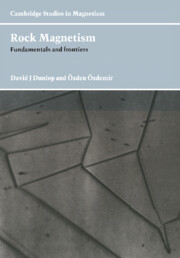Book contents
- Frontmatter
- Contents
- Preface
- Chapter 1 Magnetism in nature
- Chapter 2 Fundamentals of magnetism
- Chapter 3 Terrestrial magnetic minerals
- Chapter 4 Magnetostatic fields and energies
- Chapter 5 Elementary domain structures and hysteresis
- Chapter 6 Domain observations
- Chapter 7 Micromagnetic calculations
- Chapter 8 Single-domain thermoremanent magnetization
- Chapter 9 Multidomain thermoremanent magnetization
- Chapter 10 Viscous and thermoviscous magnetization
- Chapter 11 Isothermal magnetization and demagnetization
- Chapter 12 Pseudo-single-domain remanence
- Chapter 13 Crystallization remanent magnetization
- Chapter 14 Magnetism of igneous rocks and baked materials
- Chapter 15 Magnetism of sediments and sedimentary rocks
- Chapter 16 Magnetism of metamorphic rocks
- Chapter 17 Magnetism of extraterrestrial rocks
- References
- Index
Chapter 4 - Magnetostatic fields and energies
Published online by Cambridge University Press: 06 July 2010
- Frontmatter
- Contents
- Preface
- Chapter 1 Magnetism in nature
- Chapter 2 Fundamentals of magnetism
- Chapter 3 Terrestrial magnetic minerals
- Chapter 4 Magnetostatic fields and energies
- Chapter 5 Elementary domain structures and hysteresis
- Chapter 6 Domain observations
- Chapter 7 Micromagnetic calculations
- Chapter 8 Single-domain thermoremanent magnetization
- Chapter 9 Multidomain thermoremanent magnetization
- Chapter 10 Viscous and thermoviscous magnetization
- Chapter 11 Isothermal magnetization and demagnetization
- Chapter 12 Pseudo-single-domain remanence
- Chapter 13 Crystallization remanent magnetization
- Chapter 14 Magnetism of igneous rocks and baked materials
- Chapter 15 Magnetism of sediments and sedimentary rocks
- Chapter 16 Magnetism of metamorphic rocks
- Chapter 17 Magnetism of extraterrestrial rocks
- References
- Index
Summary
Introduction
Chapters 2 and 3 were concerned mainly with material properties like spontaneous magnetization, Curie temperature, magnetocrystalline anisotropy and magnetostriction. If there were no other factors to consider, exchange coupling would cause ferromagnets and ferrimagnets to be magnetized to saturation along a magnetocrystalline or magnetoelastic easy axis throughout their volumes, apart from thermal disordering at high temperatures. Such single-domain (SD) grains do exist, but in most magnetic minerals they are quite small, often < 1µm in size. Larger multidomain (MD) grains spontaneously subdivide themselves into two or more domains (Fig. 1.2). Ms is uniform within each domain (at least on a macroscopic viewing scale) but Ms vectors are in different directions in different domains.
Why do domains exist? Landau and Lifschitz (1935) recognized that the longrange effect of dipole–dipole interactions between atomic moments is to generate a magnetostatic or demagnetizing energy which eventually outweighs the tendency of exchange forces and magnetocrystalline anisotropy to produce a uniform magnetization. Without the guidance of domain observations, Landau and Lifschitz predicted the basic pattern of body and closure domains which were later (in the 1950's) observed experimentally.
Because dipole–dipole interactions are a long-range effect, involving each pair of dipoles in a crystal, magnetostatic calculations can be computationally gruelling. Visualizing the fields involved is not easy, even for quite simple magnetization distributions. Ultimately the goal is to generate magnetization structures which resemble the domains actually observed in large grains by starting from first principles, without imposing initial constraints.
- Type
- Chapter
- Information
- Rock MagnetismFundamentals and Frontiers, pp. 83 - 102Publisher: Cambridge University PressPrint publication year: 1997
- 1
- Cited by



